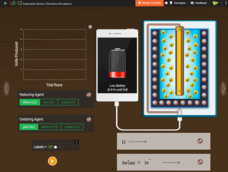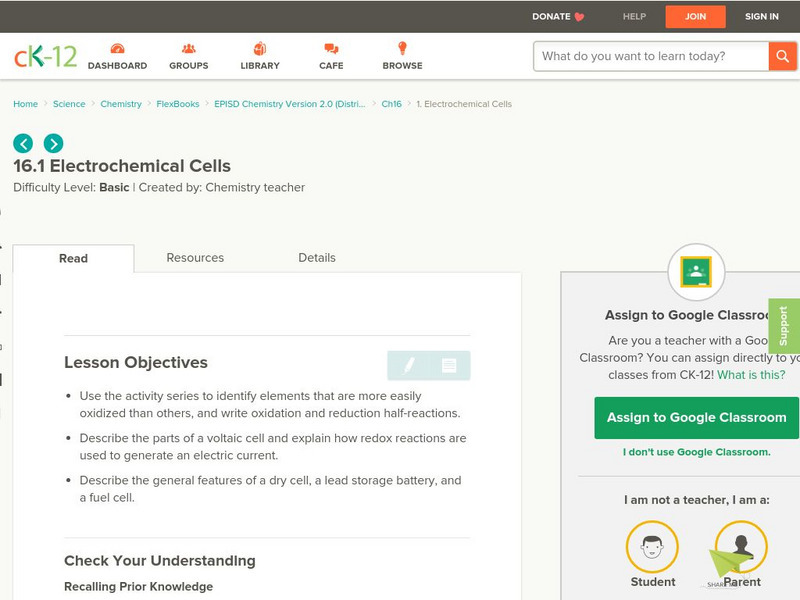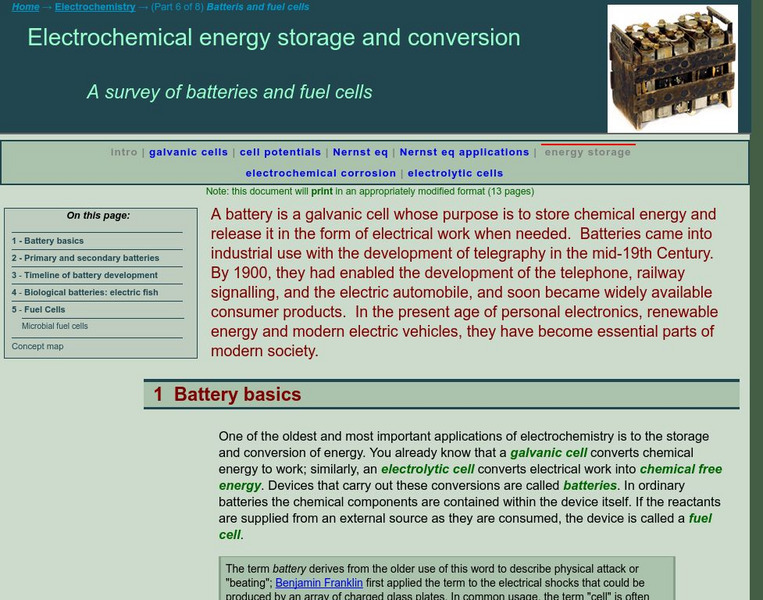Curated OER
Aluminum Adventure
Chemistry aces use an electrochemical cell to anodize a strip of aluminum. They apply an organic dye to it. In a practical application, they design a piece of jewelry out of the anodized metal and describe the process. Thorough notes...
Curated OER
2000 U.S. National Chemistry Olympiad National Exam - Part I
The National Chemistry Olympiad exams are comprehensive tests covering an entire year of chemistry concepts. You can use them as practice for competing in the challenge, or simply as a review, or as an actual final exam for your...
National Nanotechnology Infrastructure Network
Hiding Behind the Mask
Microchips are a man-made wonder. Investigate the manufacturing wonder with a hands-on inquiry-based lesson. Scholars simulate the process of pattern transfer using photoresist. Their conclusion identifies how their process replicates...
Cornell University
Making a Battery
Don't be shocked when your class has a blast making their own batteries! Science scholars examine a dry cell battery, then design and construct a wet cell battery. The activity guides them through the parts of a battery, the variables...
CK-12 Foundation
Battery
Don't take for granted the technology behind power packs. Build an understanding of the chemical mechanics of a battery pack that charges your phone. The simulation allows young scientists to manipulate the type of elements in a pack and...
Chymist
Batteries
Young scientists study the construction of a battery through experimentation. They engage in five experiments which combine to create a thorough study of the history of batteries beginning with a model of the first battery.
Exploratorium
Penny Battery
Use pennies to light an LED. Class members follow the provided directions to build a multi-celled battery powered by pennies. Using stacks of pennies of varying heights, pupils control the voltage of the battery to light...
Curated OER
Unit 8 Redox and Electrochemistry
Two topics are covered by this chemistry worksheet: redox reactions and electrochemistry. Thorough review notes are followed by a series of multiple choice questions about oxidation numbers, redox reactions, electrochemical cells, and...
Curated OER
Forcing Electrons to Move
For this electrolytic cell worksheet, students read about car batteries and how they produce electricity for cars to run. They answer six questions about electrolytic cells and oxidation-reduction reactions.
Curated OER
Redox/Electrochemistry Review Questions
In this redox review worksheet, students determine the balanced net cell reaction, calculate the value of the equilibrium constant, and write the balanced net ionic equation for reactions. This worksheet has 13 problems to solve.
National High Magnetic Field Laboratory
Magnet Academy: Simple Electrical Cell
This is a Java tutorial showing the simple voltaic (or galvanic) electrical cell, which is the most basic type of "wet" cell and demonstrates the fundamental chemistry behind batteries.
CK-12 Foundation
Ck 12: Electrochemical Cells
[Free Registration/Login may be required to access all resource tools.] Students use the activity series to identify elements that are more easily oxidized than others, and write oxidation and reduction half-reactions. Then, they...
Simon Fraser University
Chem1 Virtual Textbook: Primary and Secondary Batteries
As part of the General Chemistry Virtual Textbook, this site examines a variety of topics related to electrochemistry. In particular, this site explores a range of topics related to batteries including primary and secondary batteries,...
Texas Instruments
Texas Instruments: Energy From Foods Part Ii
In this activity, students explore how an electrochemical cell works. They use a Voltage Sensor to measure the electrical energy produced when the distance between the electrodes is varied. They also determine the factors that affect the...
Texas Instruments
Texas Instruments: Energy From Foods: Part I
In this activity, students' will use fruits and vegetables to make an electrochemical cell and develop an understanding of how an electrochemical cell works. They will use a voltage sensor to determine which fruits and vegetables produce...
Other
Seeds Foundation: Portable Manufactured Device
Explains the differences between batteries and fuel cells. Other energy sources such as the piezoelectric effect and the thermoelectric generator are explained as well. The pros and cons of these energy sources are outlined.
Other
California Science Center: Lemon Light
Try out this great electricity activity by using lemons to make a light bulb glow. You can learn about the science behind the activity and watch an animated demonstration.
CK-12 Foundation
Ck 12: Physical Science: Chemical and Solar Cells
[Free Registration/Login may be required to access all resource tools.] How chemical and solar cells work and produce an electric current.
Museum of Science
The Atom's Family: Fruity Electricity
Frankenstein's electricity is out. In this activity, students help him find another source of energy using citrus fruit. Good for students who want to do their own projects or for class lessons.
Physics Aviary
Physics Aviary: Practice Problems: Finding Internal Resistance of a Battery
Determine the internal resistance of a battery based on the electrochemical potential and the current that comes out of the battery when it is hooked to a resistor.
Physics Aviary
Physics Aviary: Practice Problems: Internal Resistance Parallel Circuit Battery
Determine the internal resistance of a battery based on the electrochemical potential and the current that comes out of the battery when it is hooked to a series of resistors connected in parallel.
Physics Classroom
The Physics Classroom: Common Misconceptions Regarding Electric Circuits
In this tutorial, preconceived ideas regarding the nature of charge flow and the role of a battery in a circuit are addressed. In many instances, these preconceived notions about charge flow and batteries are incorrect ideas and are...
Physics Classroom
The Physics Classroom: Journey of a Typical Electron
In the wires of electric circuits, an electron is the actual charge carrier. In this article, an electron's path through the external circuit is introduced.
Khan Academy
Khan Academy: Electrochemistry
We encounter electrochemical cells in all facets of our everyday lives. Learn about the two types of electrochemical cells: galvanic, also called Voltaic, and electrolytic. Discusses the reactions that take place in cells, the formulas...




















